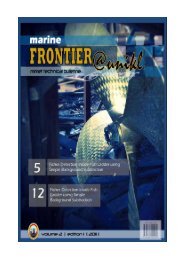click here to download - UniKL MIMET Official Website
click here to download - UniKL MIMET Official Website
click here to download - UniKL MIMET Official Website
You also want an ePaper? Increase the reach of your titles
YUMPU automatically turns print PDFs into web optimized ePapers that Google loves.
In order <strong>to</strong> update the boundary conditions, the<br />
first and the last segments are considered as<br />
two volumes (Xue and Yuzri, 2005).<br />
The equation used <strong>to</strong> calculate the mass flow rate<br />
passing through the orifice is used, which is:<br />
M� � C � C � A � P<br />
d<br />
m<br />
w<strong>here</strong> the mass flow parameter is as shown below<br />
in equation (4).<br />
C<br />
m<br />
�<br />
d<br />
2�<br />
R<br />
���1� M d is the mass flow rate passing the orifice<br />
while Cd is the discharge coefficient. A is the ori‐<br />
fice cross‐sectional area, Pu is the upstream stag‐<br />
nation pressure (absolute), Tu is the upstream<br />
stagnation temperature (absolute), γ is the spe‐<br />
cific heat ratio and Pvc is the static pressure at the<br />
vena contracta or throat.<br />
�<br />
Equation 4 is only valid when<br />
Otherwise the flow is considered <strong>to</strong> be choked and<br />
Cm will be constant at a value of 0.0405. Note that<br />
the ratio of specific heats g for air is 1.4.<br />
EXPERIMENT AND SIMULATION<br />
u<br />
��<br />
P<br />
�<br />
�<br />
�<br />
��<br />
� P<br />
vc<br />
u<br />
T<br />
The transmission line diameter is first calibrated<br />
by experiment <strong>to</strong> determine the influence of the<br />
system pressure on<strong>to</strong> changes in its radial dimen‐<br />
sion. Highly incompressible liquid (water) is in‐<br />
jected in<strong>to</strong> a polyurethane transmission line<br />
which is blocked at one end. Different pressures<br />
are then applied <strong>to</strong> the other end. By recording<br />
changes in the liquid height, the transmission line<br />
u<br />
�<br />
�<br />
�<br />
�<br />
2 �<br />
� P<br />
� �<br />
�<br />
� P<br />
��1� (3)<br />
(4)<br />
<strong>MIMET</strong> Technical Bulletin Volume 1 (2) 2010<br />
P<br />
vc<br />
vc<br />
u<br />
P<br />
s<br />
�<br />
�<br />
�<br />
�<br />
� �<br />
� 0 . 528<br />
�<br />
�<br />
��<br />
diameter changes can then be determined. Ex‐<br />
periment results are listed in Table 1.<br />
Pressure [bar] Liquid Height [mm]<br />
Table 1: Transmission Line Diameter Calibrations<br />
It is assumed that the high pressure applied only ex‐<br />
pands the transmission line along the radial direction<br />
and do not influence the dimension along the axial<br />
direction. The initial volume occupied by the water is<br />
1.<br />
88<br />
�10<br />
m 3 . Based on the assumption above,<br />
the relationship between the applied pressure and<br />
the internal diameter of the transmission line is as<br />
shown in Figure 2.<br />
0 95.82<br />
1 94.46<br />
2 93.72<br />
3 92.32<br />
4 91.59<br />
5 90.85<br />
6 89.27<br />
7 88.37<br />
�6<br />
| MARINE FRONTIER @ <strong>UniKL</strong><br />
108



